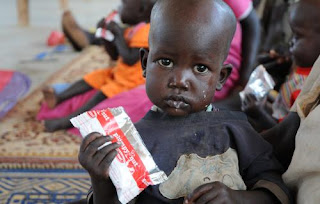Monday, April 11, 2016
Advantages, disadvantages and risks of ready-to-use foods
Breastfeeding Briefs by T. Frank, ACFin South Sudan
Globally, about 50 million children less than 5 years are wasted (too thin) at any one time; of these, over 17 million are severely wasted. These children are at high risk of death or may suffer from diseases and complications that will greatly affect their future life. Much more common is stunting (failure to achieve normal growth in length or height): it affects more than 160 million children that may not reach their developmental potential, mainly in south Asia and sub-Saharan Africa.
During the past decade or more the news media have focused on claims that the “solution” to reduce the mortality and morbidity from infectious diseases in the form of specific food products, often referred to as “ready-to-use foods.” These foods have a high nutrient density and a low water activity; thus, they do not support bacterial growth even without refrigeration. They need no cooking or other preparation and can be fed directly from their packaging with no need for training. The “ready-to-use therapeutic foods” (RUTF) are for use in the treatment of severe acute malnutrition (SAM).
The introduction of RUTFs in the management of SAM has allowed health authorities to extend effective treatment beyond hospitals, i.e. in out-patient units or at home. As a consequence, the case fatality rates recorded in hospitals, usually less than 10%, can be achieved largely outside the hospital environment, thus greatly reducing cost and the burden on in-patient health care facilities, and allowing an increased coverage. This, however, is far from universal, and many cases, possibly the worst cases, are not yet reached by programmes. In addition, proof of the advantages of RUTFs over other products is weak. In addition, RUTFs have their downside. They are too expensive to be used for anything else besides treatment of SAM. Their provision depends often on short-term external funding for humanitarian or emergency programmes. They tend to be monopolized by a handful of manufacturers able to put in place strict quality control measures. Children treated with RUTFs require extra water; if clean water is not available, RUTF alone will not result in a healthy child. The product does not contribute to teaching the child to like the taste of the healthy local foods needed to avoid malnutrition in the future. Finally, they are only part of the solution: prevention and rehabilitation of SAM need much more than RUTFs. And SAM is only the tip of the malnutrition iceberg: 90% of malnutrition consists of forms other than SAM, and RUTFs are neither necessary nor appropriate in treating them.
Subscribe to:
Post Comments (Atom)


No comments:
Post a Comment